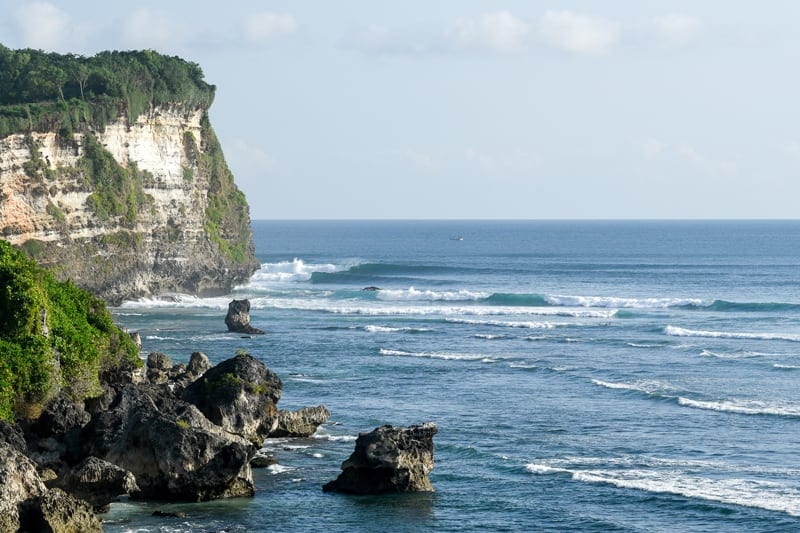
Surfing in Bali is everything it’s chalked up to be—and more. This little island in Indonesia is overflowing with natural beauty and magical vibes—and the waves are also pretty darn magical.
If the beauty, magic, and surf weren’t enough, the water temperature averages around 85 °F (29 °C), the Balinese are some of the friendliest people around, the food is amazing, and your money goes a long way.
In this Guide to Surfing Bali, we cover everything you need to know to plan a surf trip to the “Island of the Gods,” including when and where to go, the lowdown on the surf, places to stay, and how to manage transportation.
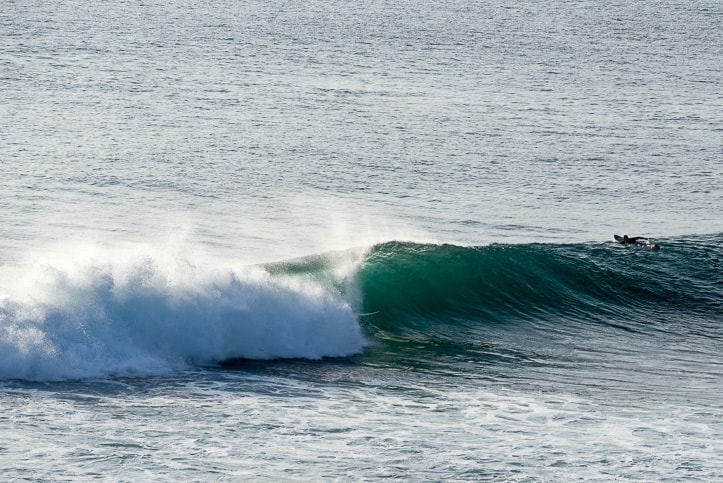
Want to have the best surf trip to Bali?
We specialize in bespoke luxury surf trips to Bali, tailored to your surf level and preferences. Enjoy an expertly-planned surf vacation with insider surf intel, the best local surf coaches, stunning villas, talented private chefs, surf photography, and more. We’ve vetted and curated the crème de la crème in Bali and bring everything together to create dream surf getaways. Learn more.
For info on surfing other regions of Indo, check out our Guide to Surfing Indonesia >>
Surfing Bali
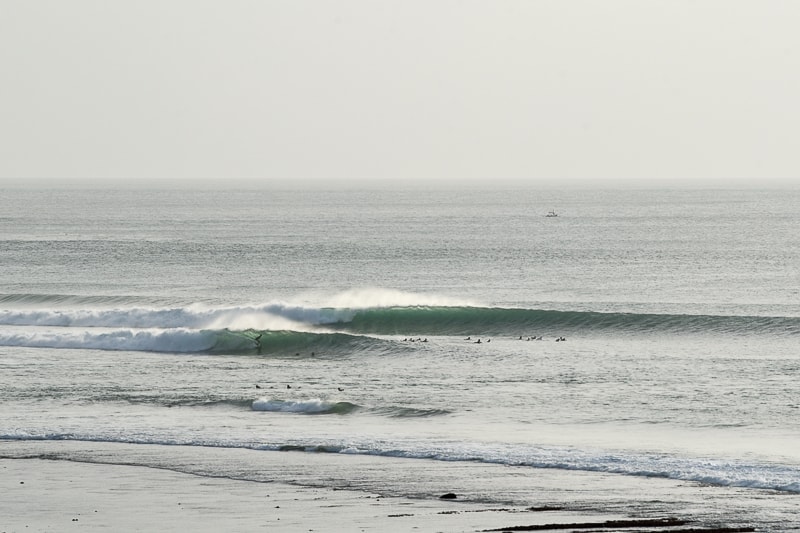
Indonesia is home to some of the best waves on the planet, and Bali is no exception. With so much surf within a relatively small area, there are almost always great waves to be found. The Bukit Peninsula on the southwest corner of the island has some of the best surf in Bali, and its off-the-beaten-path vibe is perfect for those who want to avoid the busy touristy areas of Kuta and Seminyak.
Tourism in Bali was sparked by surfing in the 1960s and the waves have continued to attract surfers from around the world ever since. Today, the more well-known spots can get quite crowded in the high season, but with some determination and luck, it’s possible to enjoy a relatively empty session every now and then.
A big bonus with surf trips in Bali is that if there are a few flat days on your trip, there are plenty of awesome activities to keep you busy—everything from exploring temples and waterfalls to lying around gorgeous pools and beaches, or even getting your party on (if that’s your cup of tea).
Where to Surf in Bali
Bali has a number of different surf zones that fire under different conditions and seasons. The Bukit Peninsula on the southwest corner of the island is the main area most people think of when it comes to surfing Bali, for a number of reasons. This was the first zone properly explored and documented, it enjoys the perfect combination of offshore wind consistent swell during the dry season, and there are a lot of high-quality left-hand reef breaks and reef points on offer, including Uluwatu, Padang Padang, Bingin, and Impossibles.
Further north, the west coast also enjoys offshore wind during the dry season (when the southeast trade winds blow), although the waves tend to be a bit smaller and more user-friendly than on the Bukit. These include Canggu, Old Man’s, and Medewi.
Finally, the east coast has a bunch of right-hand reefs and points that turn on during the wet season, when the trade winds stop blowing and the morning conditions are often glassy or light offshore.
Surf Seasons and Swell Info
The Southern Indian Ocean supplies Indo with consistent solid swells, so surf can be enjoyed year-round. That being said, the island has two distinct surf seasons: the wet and dry seasons. The cooler dry season from May to September is the best time for Bali’s west coast, which is jam-packed with breaks, including world-famous spots like Uluwatu and Padang Padang. From June to August, in particular, Bali’s winter brings large swells and strong offshore winds for the west coast breaks.
The wet season in Bali is during the summer and fall (roughly November to March), with October, April, and May considered shoulder months. During the wet season, the wind blows primarily from the west, so the east coast breaks get offshore winds and come into play. This is the time of year that spots like Keramas, Serangan, Sri Lanka, and Sanur produce world-class conditions. While the west coast serves up primarily lefts, the east coast is full of right-hand breaks.
Types of Surf Breaks
World-class coral reefs, rock reefs, lava reefs, scattered beach breaks, river mouths, and points. Bali is home to a wide range of different types of surf breaks, but reef breaks are the most common.
Level of Difficulty
Bali is known for world-class surf, so it definitely attracts (and is well-suited to) intermediate to expert surfers who are seeking epic waves and comfortable with navigating crowds. That being said, there’s something for everyone. Lots of people learn to surf in Bali, as there are plenty of great beginner surf retreats and private lessons available. You can find other beginner-friendly waves (even when it’s pumping) with the help of a local surf guide.
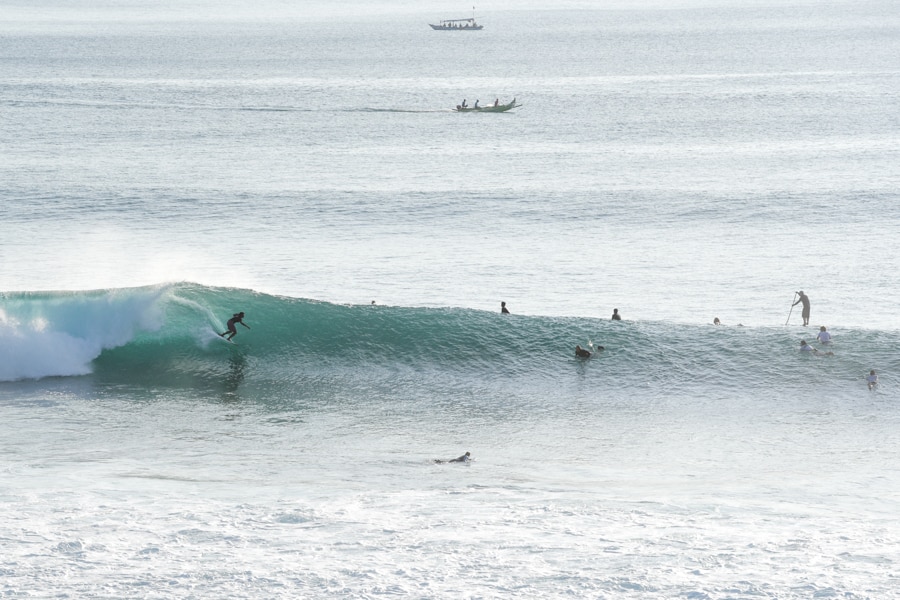
Crowds
Bali is one of the most popular surf destinations on the planet. It is often very crowded, especially during the peak season and in the more popular areas. Many of the best waves in Bali have charter boats and surf camps that keep them plenty busy. There are also many expats and local rippers who have their go-to breaks on lockdown, so the competition is typically pretty stiff. That being said, you can occasionally find windows where you’re out with just a small group of other surfers.
When surfing Bali, always show respect, spread friendly vibes, practice good wave etiquette and patience, and do your best to get in the rotation.
Water Temperature
The water temperature in Bali is comfortably warm, ranging from about 80–84 F. (27–29 C.), with pretty insignificant changes in temperature from the wet to dry seasons. You’ll be fine in board shorts/bikinis and a rash guard most of the time. You may choose to wear a thin 1–2mm top if you’re surfing in the morning or want some extra protection from the sun and reefs, but you will likely get overheated if you wear a wetsuit top in the middle of hot, sunny days.
Getting to the Surf
How you access the surf depends on where you’re staying. We recommend picking a place with close proximity to the spot you want to surf the most, so you can keep a watchful eye on it and pounce when the stars align and the crowds, tides, and winds are just right. Hiring a private driver is a convenient way to explore Bali’s legendary surf spots (we’ll cover transportation in detail later in the guide). For certain breaks, especially outer reefs, a boat trip may be the way to go. Many luxury resorts and concierge services can arrange private charters, making it easy to reach more remote surf spots.
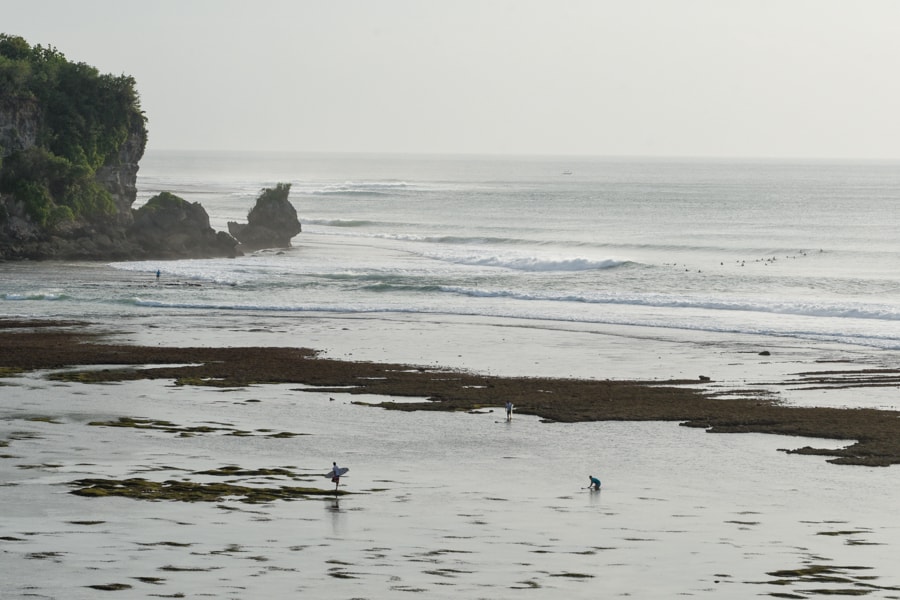
Good to Know
There are a lot of reef breaks in Bali, and oftentimes you’ll have to walk across reefs to get to breaks. Most of the surf breaks on the Bukit Peninsula (Uluwatu area) involve 50- to 100-meter walks across jagged reef. Obviously it depends on your comfort and tolerance for hoofing it across the sharp reef, but you might want to bring some booties along.
Surfboard Rentals
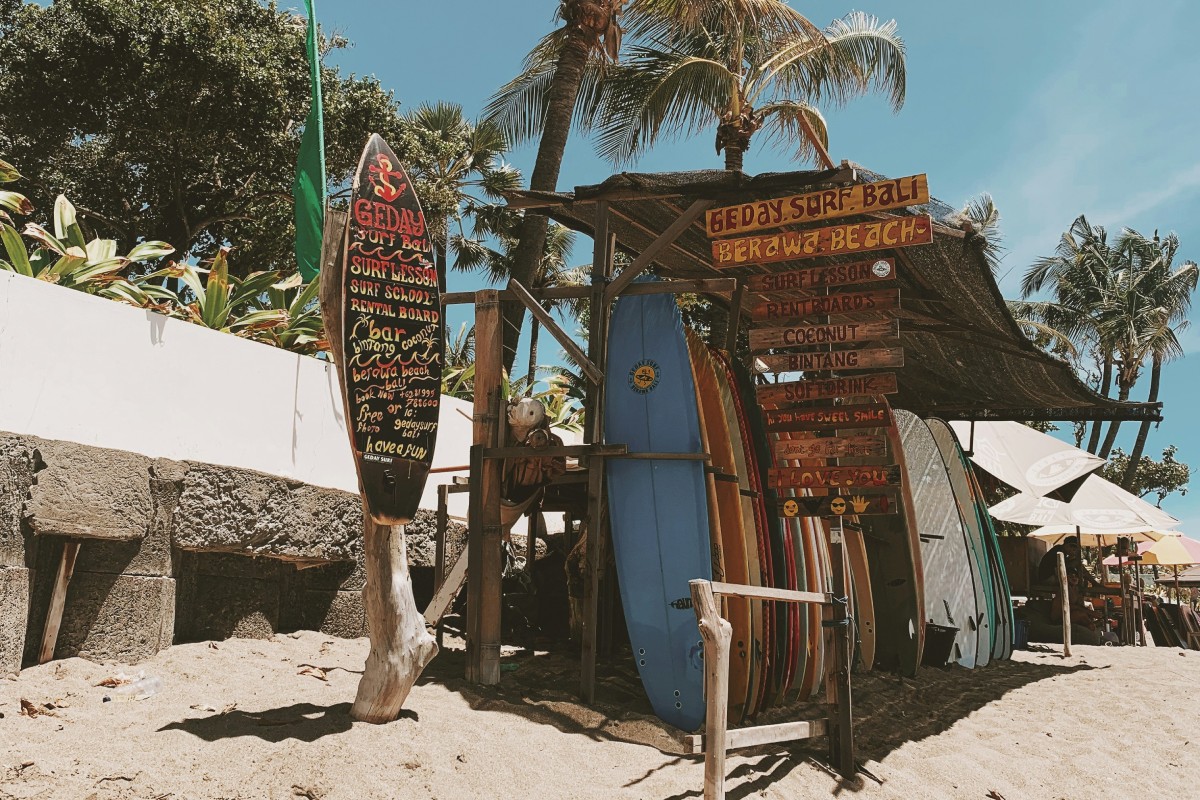
If you’re a beginner, there’s no reason to bring a surfboard with you, as many surf schools and lessons will include board rentals. And even if you’re not taking lessons, there’s plenty of boards you can rent on an hourly or daily basis.
If you’re an intermediate to advanced shredder, there’s obvious pros and cons to bringing your own boards—the cons being the risk of board damage and inconvenience of lugging your boards around, while the pros include having your own boards and not having to hassle with searching for the right board to rent.
The more tourist-heavy areas like Kuta and Seminyak will have the most options for surfboard rentals, but in quieter areas like on the Bukit Peninsula (Uluwatu area), there can be slim pickings. There are a lot of funky damaged boards, while only a few shops have newer boards that you can demo. That being said, at many of the specific breaks, there are shops or warungs that have boards for rent—you just have to ask around.
If you’re planning to rent a surfboard, keep in mind that vendors near the breaks sometimes rent boards by the hour, which can be inconvenient if you’re hoping to surf multiple sessions throughout the day. For more flexibility, it’s better to arrange a longer-term rental through a reputable surf shop or your accommodation, where you can rent by the day or even for the entire length of your stay.
Many high-end resorts and private villas offer premium board rentals or can arrange to have a selection of boards delivered directly to you. This saves you the hassle of hunting down the right board and gives you more time to enjoy the waves.
You can read more about board rentals in our article on tips for surfing Uluwatu.
All things considered, if you’re an intermediate to advanced surfer, we highly recommend bringing your own boards on your trip. Alternatively, there are some awesome shapers in Bali, so you could buy a board in Bali and bring it home with you.
Surf Lessons
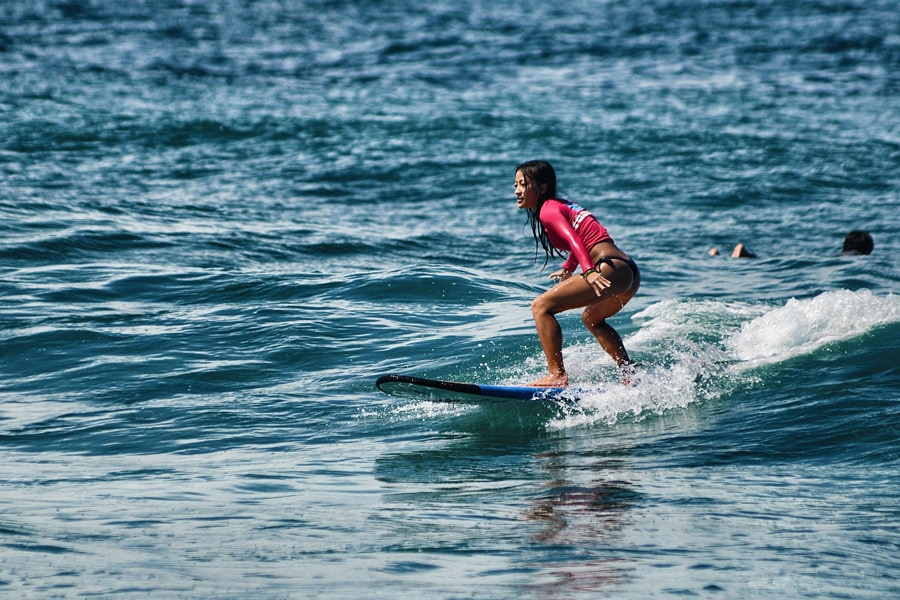
As one would expect with Bali’s reputation as a premier surf destination, there are plenty of options for surf lessons, especially around Kuta, Seminyak, Canggu, and Uluwatu. While conditions change on a daily basis, the most popular world-class breaks on the Bukit Peninsula and Nusa Lembongan are often best suited for intermediate to expert surfers. That said, there are also spots for beginners to go—just make sure you’re with a trusted surf instructor or guide if trying to navigate the area as a novice surfer.
If you’re interested in learning how to surf or refining your skills, booking private lessons or a personalized surf retreat is the way to go. Some retreats and surf schools in Bali offer customized experiences, including daily one-on-one coaching with professional instructors who tailor each session to your skill level and goals.
Surf Charters
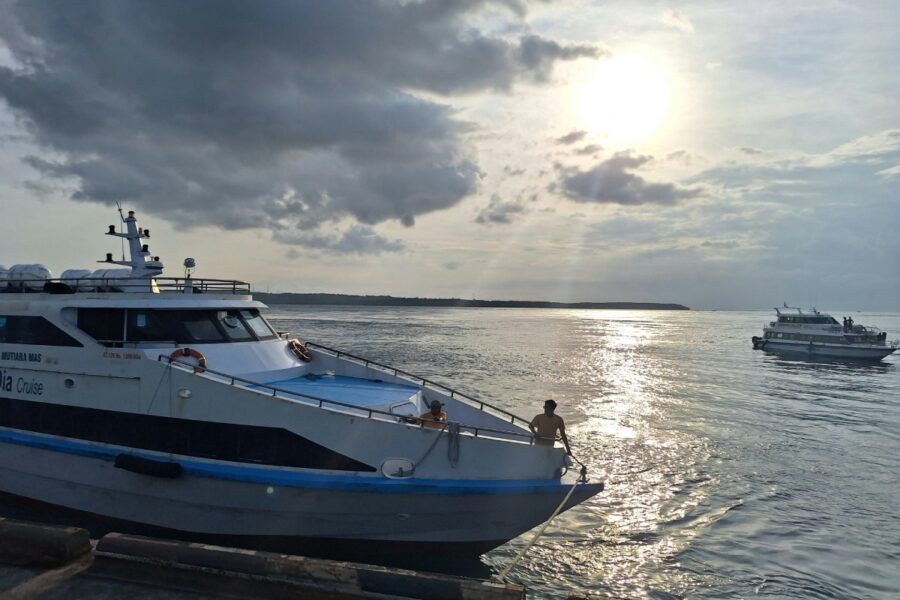
Surfing Bali via a surf charter is an incredible way to experience the island’s best waves—and the options are as varied as the surf itself. Charters range from quick half-day or full-day excursions to multi-day or even multi-week voyages for those looking to fully immerse themselves in the island’s surf scene.
Shorter trips are great for hitting nearby breaks like Uluwatu or Keramas with the guidance of experienced local crews, while longer surf charters can take you further afield to explore remote, less-crowded spots along Bali’s coastline, or even the neighboring islands.
Top Bali Surf Spots
Bukit Peninsula Surf Spots
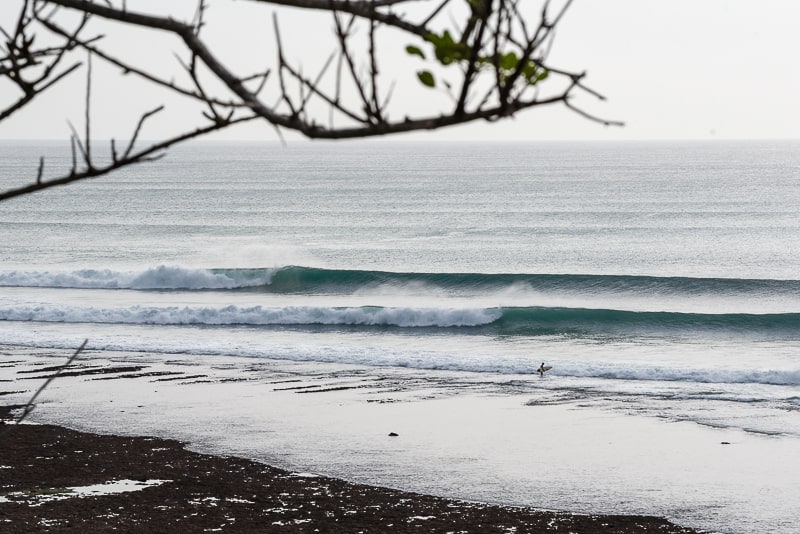
Balangan
A left-hand reef break that’s popular among intermediates and improvers when it’s in the chest- to head-high range. The wave typically has many sections at that size, but it can be plenty of fun for average surfers, and some waves have better shape. More advanced surfers will enjoy plus-sized days when the walls tend to line up better.
Bingin
Bingin is a short left-hand reef peak that barrels like clockwork with the right tide and swell. The takeoff zone is pretty compact, so you need to be comfortable in a crowded and tight lineup to get any waves. Be sure to kick out before the reef goes dry on the inside end section.
Impossibles
Within eyesight of Bingin, Impossibles is a left-hand reef break that got its name from the fast, racey sections that are often impossible to make. But on a decent long-period south swell and low to mid tide, it can get very fun and rippable.
Uluwatu
Uluwatu is actually a cluster of six different left-hand reef breaks on the southwest tip of the Bukit Peninsula. From the far left point to the right you’ll find Secrets, Temples, Bombie, Peak, Outside Corner, and The Racetrack. You can check out our full Guide to Surfing Uluwatu for more details on each of the peaks, but in summary, it’s an epic cluster of punchy and hollow reef breaks, and one of the premier surf spots in Bali.
Green Bowl (AKA Green Ball)
Located on the south side of the Bukit Peninsula, Green Ball is a right-hand reef break that requires a bit of a trek down a few hundred stairs. The break is known for having strong currents, but that’s mostly on the bigger swells with more energy in the water. The right is the main attraction, with sections that can be crumbly or hollow depending on the tide and size. Head high and mid-tide is a good time to go. Wind is the enemy, so try to get on it early.
West Side Surf Spots
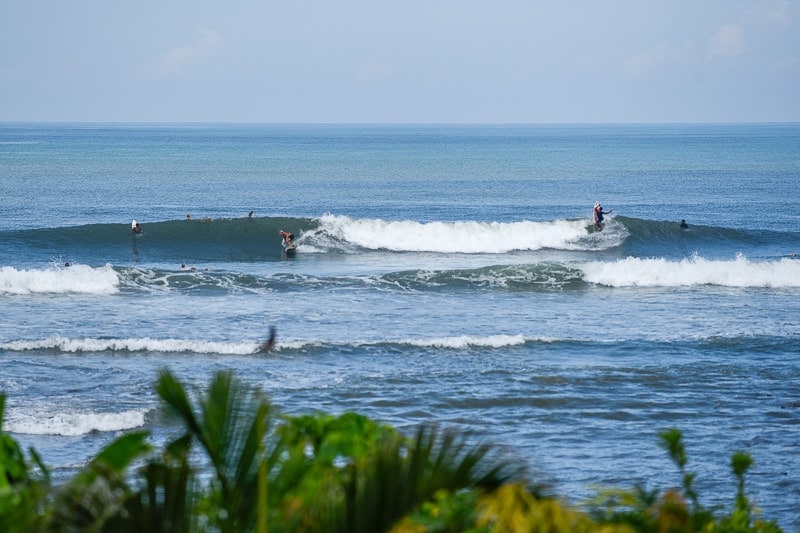
Canggu
Canggu is home to black-sand beaches, a variety of beach break peaks with some patches of reef (typically best in the head-high to slightly overhead range), and a river mouth on the north end of the beach toward Perenenan, with both lefts and rights. This area can be tide sensitive. Mid tide is typically best, with some punchy and hollow sections up for grabs.
Old Man’s
Located on the south side of town, Old Man’s is a longboard-friendly stretch of cruisey rights and lefts that attracts all sorts of wave-riders and is a popular hangout for just about everyone.
Balian
A fun-for-all-levels rocky river mouth break that can hold overhead swell. Not as powerful as the reefs of Uluwatu, but rippable and user-friendly, with the occasional inside barrel. Picks up lots of swell and offers both lefts and rights, with the left being the main attraction.
Medewi
About an hour or so north of Balian, Medewi is a fun, long, mellow, sand-bottom/cobblestone left-hand point break. When the swell angle is the right mix of south-southwest, the wave can connect and run for several hundred yards.
East Side Surf Spots
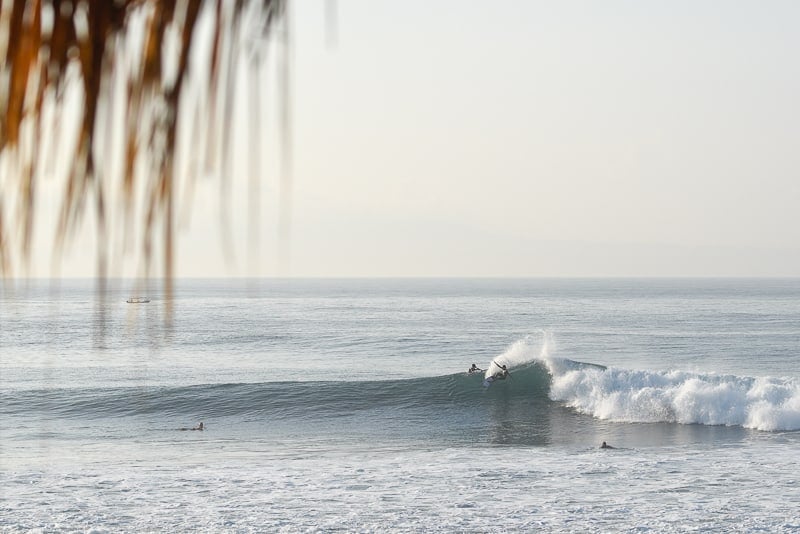
Keramas
One of the crown jewels of the east coast of Bali. Keramas has made appearances as a stop on the World Surf League Championship Tour. The wave is a powerful right-hander with heavy lips and hollow barrel sections, and is typically better suited for more advanced surfers.
Sanur
A hollow, dredging, expert-only right-hander over shallow reef, Sanur is a critical and challenging wave that needs a solid swell to come to life. It is known to have a bit of localism, so mind your p’s and q’s.
Serangan (Turtle Island)
Serangan features a-frame peaks (rights and lefts) that break over coral reef, with rippable and sometimes hollow sections on offer, depending on the tide and swell size. The wave breaks on all tides. This is a very popular spot during the wet season, from October to April. Located right in front of a rock jetty.
For info on surfing other parts of Indo, check out our Guide to Surfing Indonesia >>
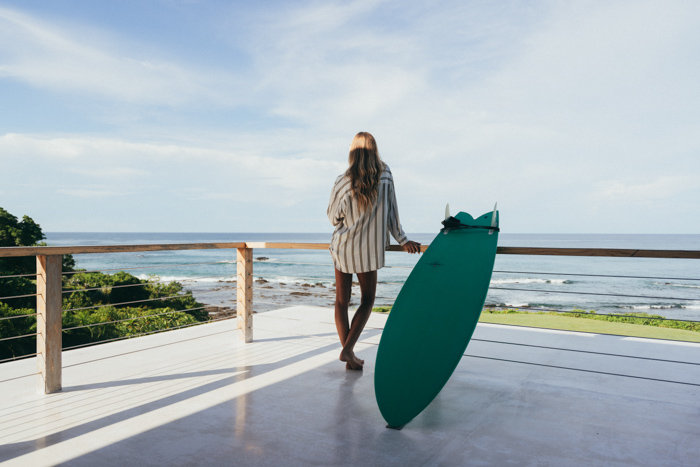
Epic surf trips made easy.
Explore luxury done-for-you surf vacations with Lush Palm Private Retreats.
Where to Stay
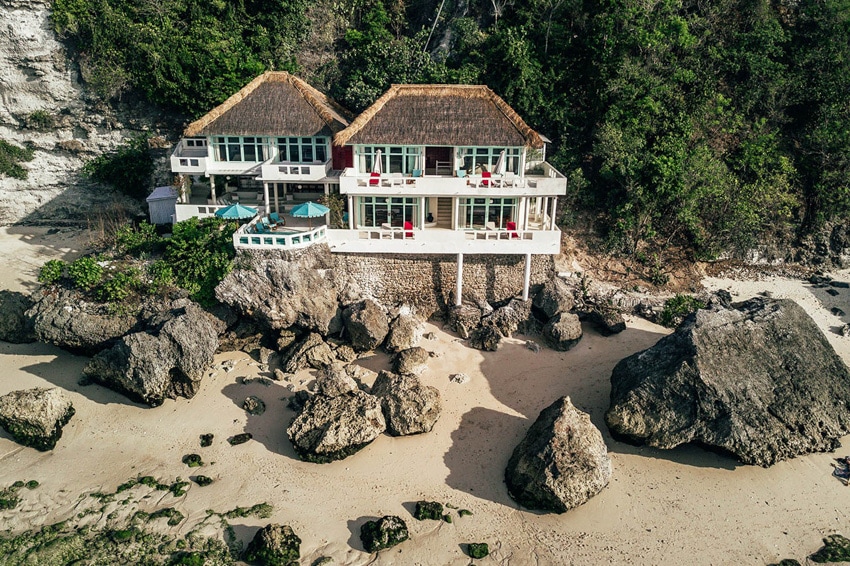
From private villas with infinity pools to boutique hotels with thoughtful designs and warm hospitality, there’s no shortage of incredible accommodation options on Bali.
For surfers specifically, there are retreats and getaways designed to help you make the most of your time in the water. Many packages include beautiful accommodations, curated meals, private surf lessons, and transportation to the best breaks.
A couple of the most popular areas for surfing Bali are Canggu and the Uluwatu area on the Bukit Peninsula. That said, there’s great surf to be found in many other parts of the island like the East side (Keramas/Sanur area), Balian, Medewi, and the nearby island of Nusa Lembongan.
At Lush Palm, we specialize in bespoke luxury surf trips to Bali, tailored to your surf level and preferences. Enjoy a 5-star surf vacation with insider surf intel, the best local surf coaches, stunning oceanfront villas, talented private chefs, surf photography, and more. We’ve vetted and curated the crème de la crème in Bali and bring everything together to create dream surf getaways. Get in touch here to start planning your trip.
Below are just a few of the many stunning properties we have available for your surf vacation in Bali. We hand-pick properties based on design, amenities, and proximity to surf breaks.
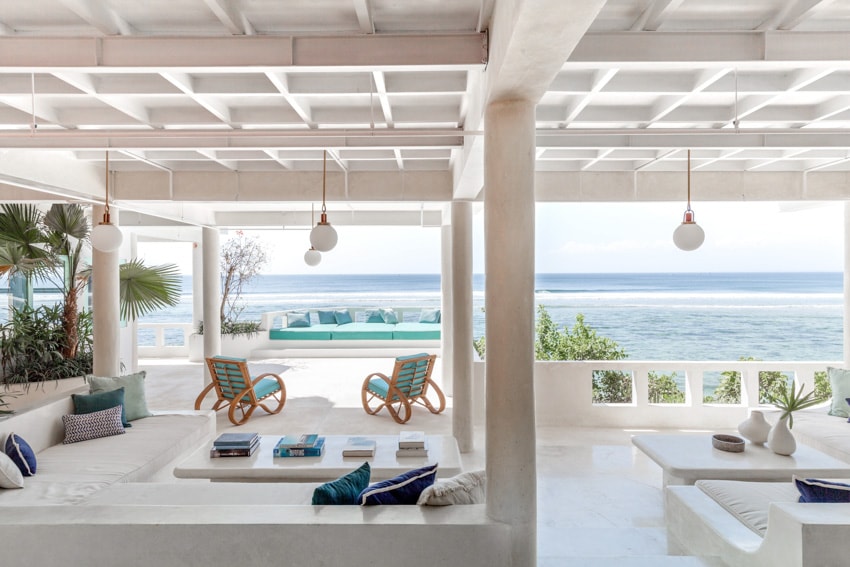
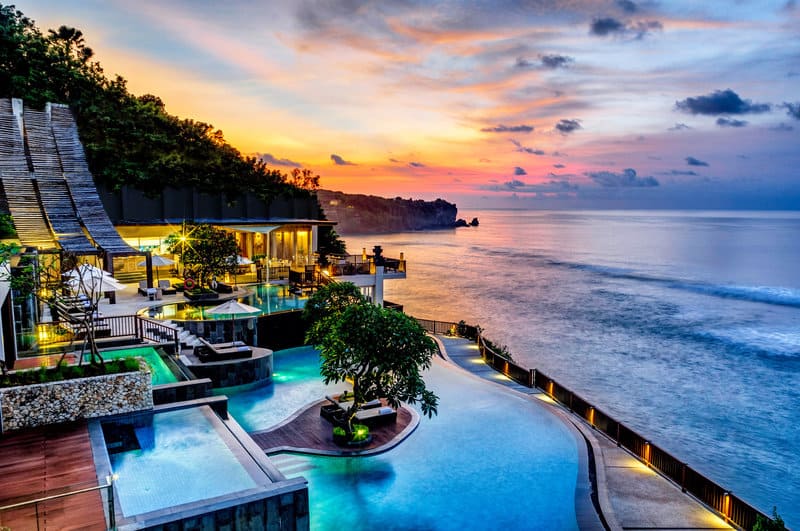
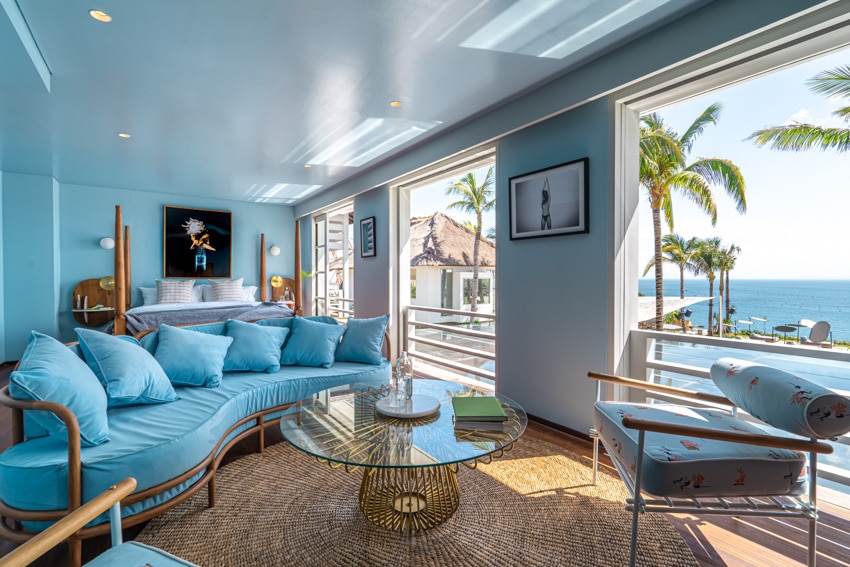
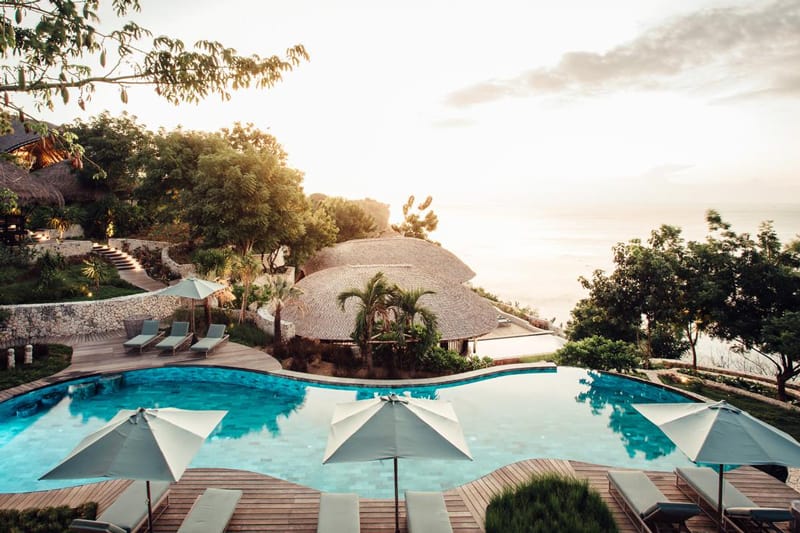
Bali Travel Basics
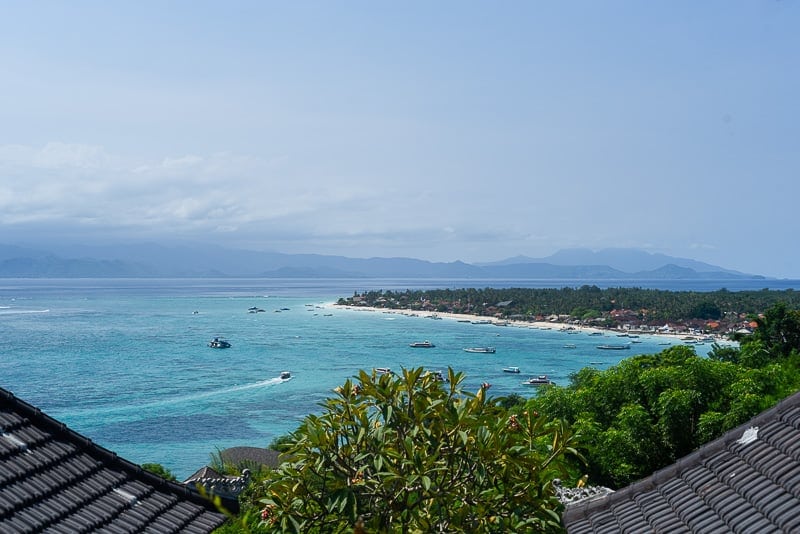
Seasons and Weather
Low Season
Bali has two low seasons: January through April and October through November. The low season coincides with Bali’s rainy season, but rainfall isn’t excessive, so you’re still able to do most activities.
Shoulder Season
Shoulder season in Bali falls during May, June, and September. These months are an ideal time to visit Bali because the weather is dry and it is a great time for surf. Plus, you’ll avoid the peak-season crowds and enjoy a more relaxed vibe.
High Season
High season in Bali is July and August, as well as Christmas and New Year. It goes without saying that there are more crowds and traffic than other parts of the year, but July and August are also prime season for swell, so the crowds can be worth it for some people.
Weather
Bali has a fairly consistent tropical, humid climate year round. The average temperature is around 86 F. (30 C.), with a humidity level of about 85%. Bali has two main weather seasons: the dry season (April–September) and the rainy season (October–March).
Currency
The Indonesian rupiah (IDR) is the currency of Bali (and all of Indonesia). As of May 2025, the exchange rate was around 16,500 rupiah per US dollar.
Tipping
Tipping is not expected or encouraged, although it is acceptable for outstanding service at nicer restaurants. Some more upscale restaurants add a non-negotiable tip to your final bill, which can range from 5–10% (these added tips are always disclosed on the menu).
Staying Connected
Bali has pretty good internet availability, in part due to the strength of the tourism industry. High-end accommodations will likely have faster, better internet. Many restaurants and cafes also provide free Wi-Fi.
As with anywhere, the further off the beaten track you get, the less internet access you’ll find. That being said, you should still be able to find decent Wi-Fi in rural Bali. If you need data for your phone, the easiest option is to pick up a SIM card at the airport or a store. Telkomsel is a large Indonesian phone company with good coverage.
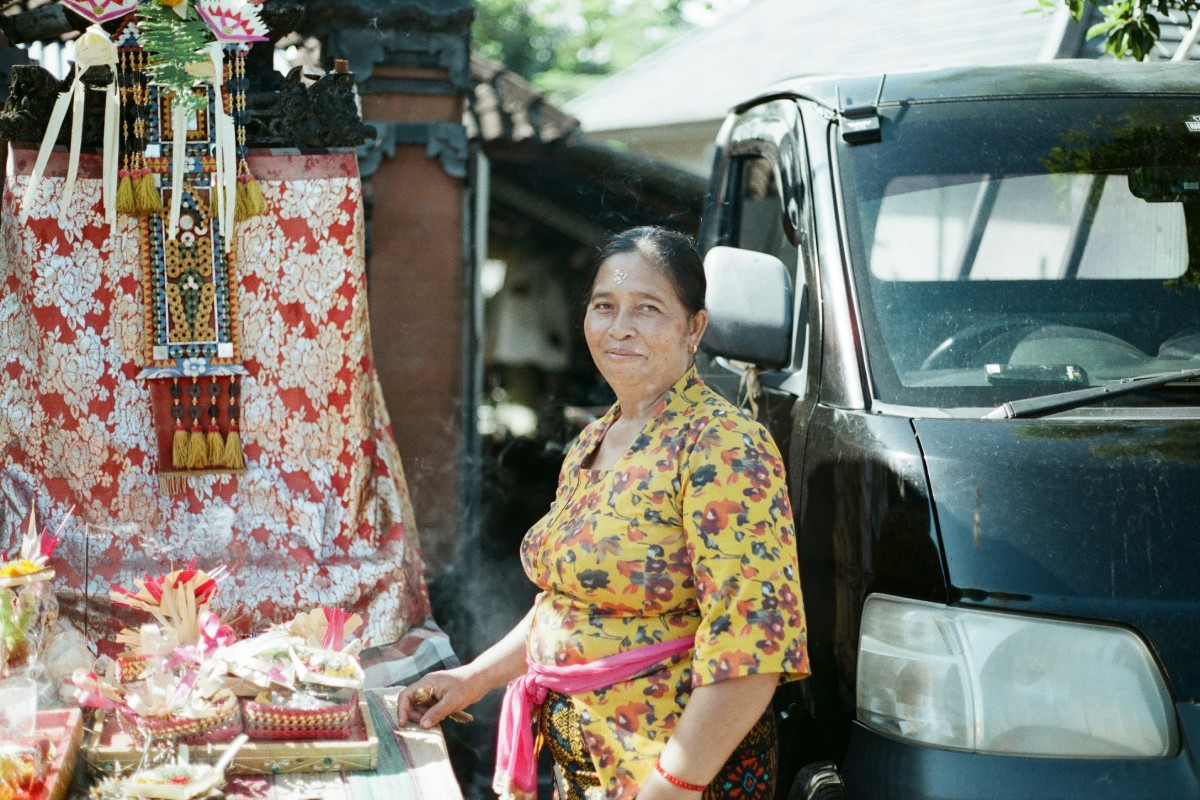
Language
The main languages spoken on Bali are Bahasa Indonesian and Balinese. Bahasa Indonesian is the official language of Indonesia and the one in most government, mass media, etc., in Bali. In addition to speaking Bahasa Indo, most Indonesians are fluent in one or more of the 700 indigenous languages (examples include Balinese, Javanese, and Sundanese). Most Balinese are bilingual, if not trilingual (Indonesian, Balinese, and English). Many locals who work in the tourism industry will speak some English, but English comprehension may be fairly limited in more remote areas. Here are a few Bahasa Indonesian words to get you started.
- Good morning: Selamat pagi (s’lah-mawt pag-jee)
- Good day: Selamat siang (s’lah-mawt see-ung)
- Good afternoon: Selamat sore (s’lah-mawt sore-eh)
- Good night: Selamat malam (s’lah-mawt maw-lahm)
- Please (can I have?) = Minta (min-tah)
- Please (help me) = Tolong (toe-long)
- Thank you: Terima Kasih (teh-ree-mah kah-see)
- You’re welcome: Sama Sama (saw-ma saw-ma)
Water
Tap water in Bali is not drinkable, so always drink bottled water. We also recommend brushing your teeth using bottled water to avoid the dreaded Bali belly.
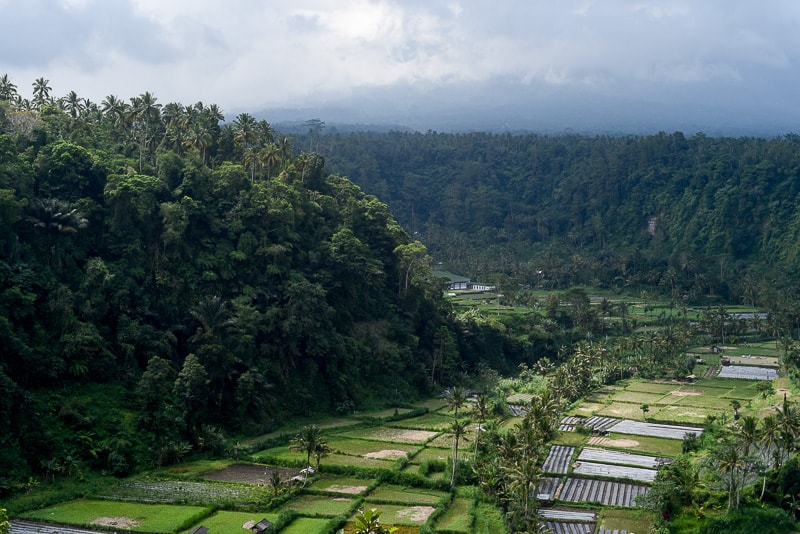
Good to Know
Here are some etiquette tips that will be helpful during your trip to Bali:
- Don’t use your left hand to shake hands, touch, or give. This has to do with the left hand being used for hygienic purposes. Balinese traditionally don’t use toilet paper (they use water), and the left hand is reserved for bathroom duties. Therefore, the left hand is considered somewhat dirty and should never be used to touch other people or to hand something over.
- Dress and act modestly. This doesn’t mean you need to cover up entirely or cut out all PDA, it’s just good to be aware that Balinese people are more conservative than Westerners and frown upon public displays of affection. In more touristy areas, it’s pretty relaxed—just be particularly considerate near temples or in rural parts of Bali.
- Temple etiquette. When visiting Balinese temples, both women and men should wear shirts that cover their shoulders and parts of their upper arms. Special leg coverings are also mandatory. Both women and men must wear sarongs (kain kamben) around their legs and temple scarves (selendang) around their waists. Feel free to bring your own, but at most temple entrances you can rent both items for use during your visit.
Eat & Drink

Whether it’s a flavorful plate of mie goreng (fried noodles) or a beautifully prepared seafood dish, it’s hard to find food in Bali that isn’t delicious. Bali is a foodie paradise, especially if you like it spicy! Fragrant spices, exotic island ingredients, and slow cooking techniques pack tons of flavor into a wide range of colorful dishes.
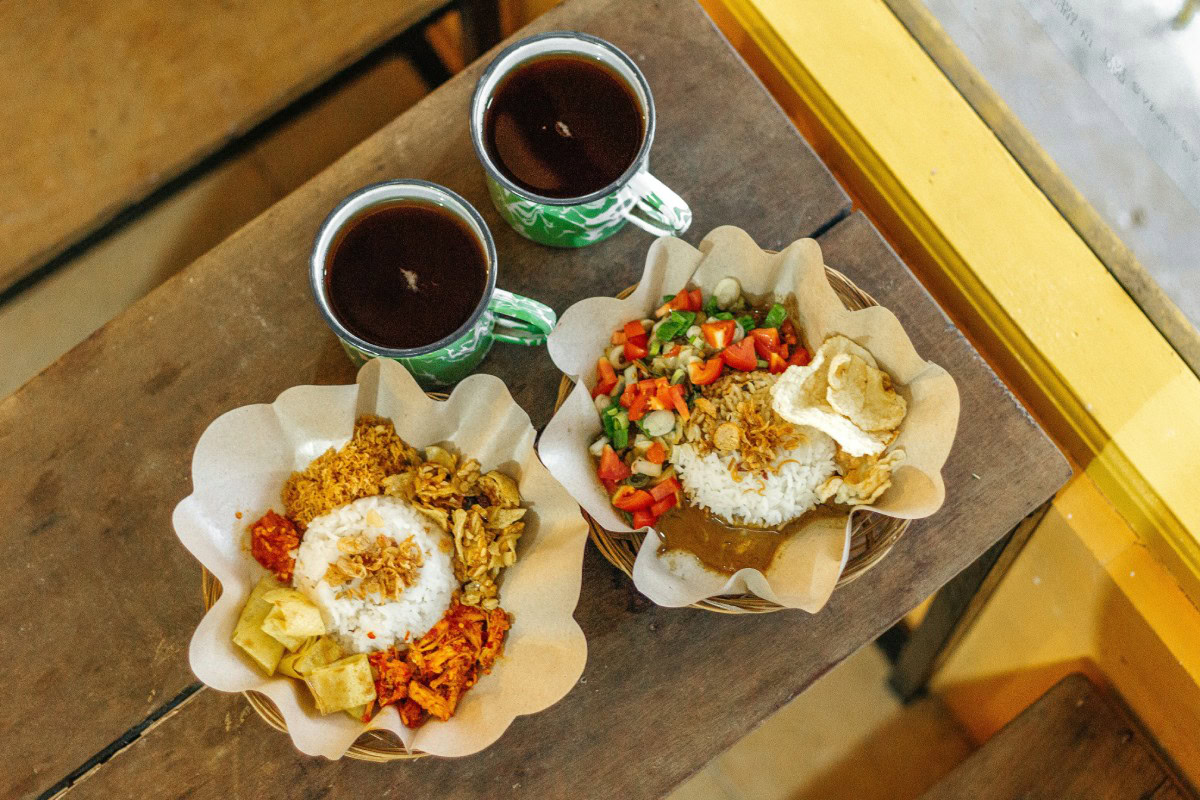
There are plenty of options for both meat eaters and vegetarians alike. For meat eaters, you’ll definitely want to try local specialties like babi guling (slow-roasted sucking pig), sate (marinated and skewered grilled meats), bebek betutu (slow-cooked duck), and fresh seafood dishes.
For vegans and vegetarians, you’ll find heaps of fantastic options all over the island. As you can imagine, fresh tropical fruits and vegetables make for some amazing vegan dishes. Many restaurants offer tofu and tempe, along with plenty of vegetable, rice, and noodle dishes to choose from.
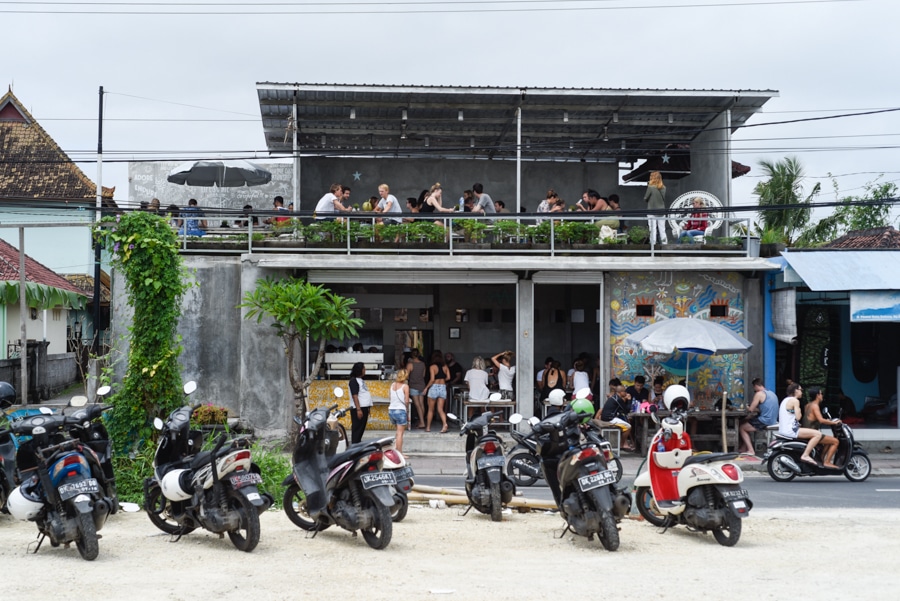
If you’re not into Indonesian food for some (crazy!) reason, just about every other type of cuisine is available, from Italian and Mexican to Californian. Canggu, the Uluwatu area, and Ubud all have a growing selection of impressive restaurants with top-quality food and design to choose from.
Transportation
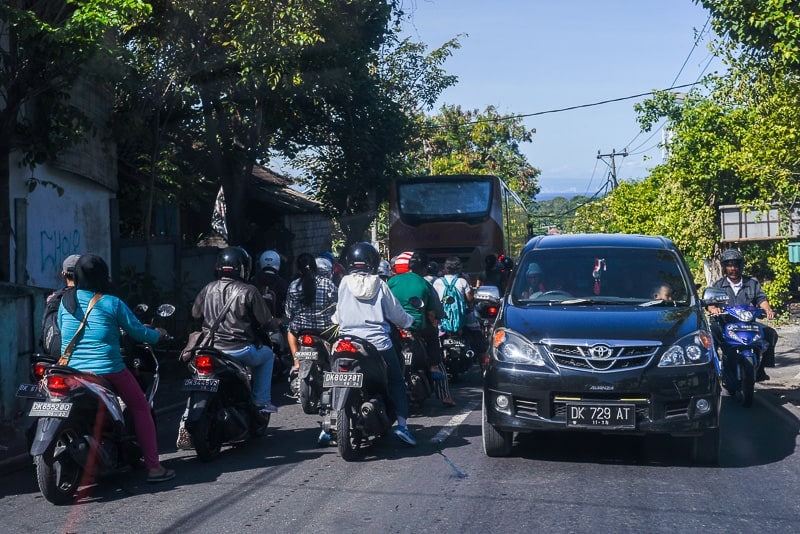
Transportation in Bali is pretty straightforward, as there aren’t a lot of options. The good news is that you don’t need a lot of options, because the ones that are available are both easy and good value, especially if you’re traveling with two or more people. You can either hire a driver or rent a car (or scooter). We’ll go into detail about those options below.
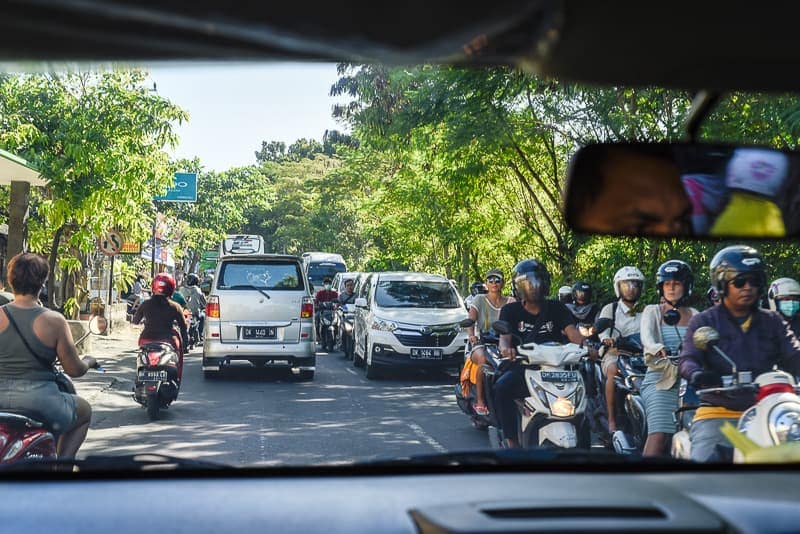
Hiring a Driver
When you’re traveling long distances (30+ minutes), the best way to get around is hiring a driver. If you’re new to the idea, this might sound like a hassle, but hiring a driver/car in Bali is actually the safest and easiest way to get somewhere. Driving in Bali is a crazy mad dash of disorganized chaos. Motorbikes weave in and out of traffic, people barely pay attention to what few traffic signs there are, and it’s pretty much a total free-for-all. With that being said, drivers in Bali are used to this chaos and navigate it well, while non-locals often have an extremely hard time driving. Just take our word for it and do yourself a favor—hire drivers to get around.
Renting a Car
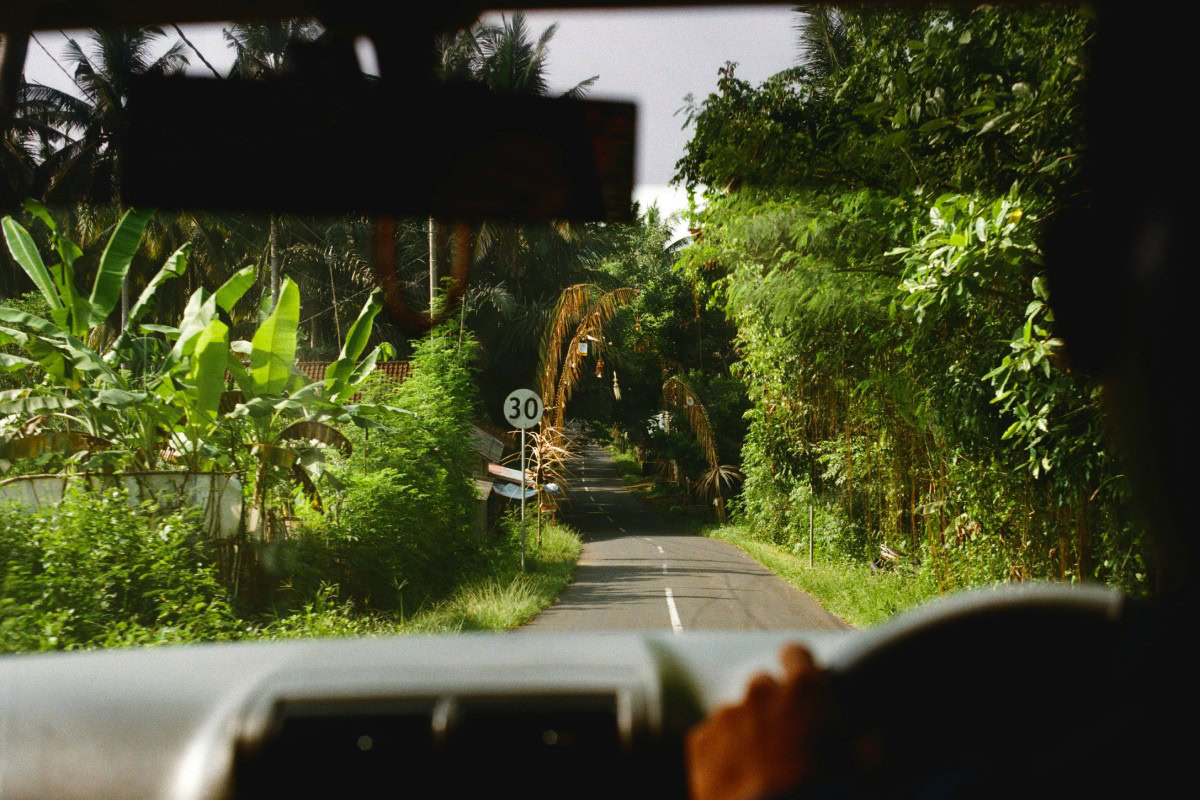
Another popular option for getting around in Bali is renting a car, which offers comfort, convenience, and a safer alternative to scooters—especially if you’re planning longer trips or traveling with surfboards. Many vehicles have roof rails, making it easy to use portable soft racks, which can be rented or purchased locally if needed.
That said, driving in Bali can be hectic, particularly in the more crowded areas like Kuta and Seminyak, where traffic can be intense. Hiring a private driver along with your car rental is a common option for those who prefer to sit back and enjoy the ride without navigating the busy roads themselves.
Renting a car is especially ideal if you’re staying in more rural areas, like the Bukit Peninsula. The open roads and lighter traffic make it easy to cruise between stunning surf spots, charming villages, and cliffside cafes. It’s a great way to explore Bali in comfort while having plenty of room for your boards and gear.
Boats and Private Charters
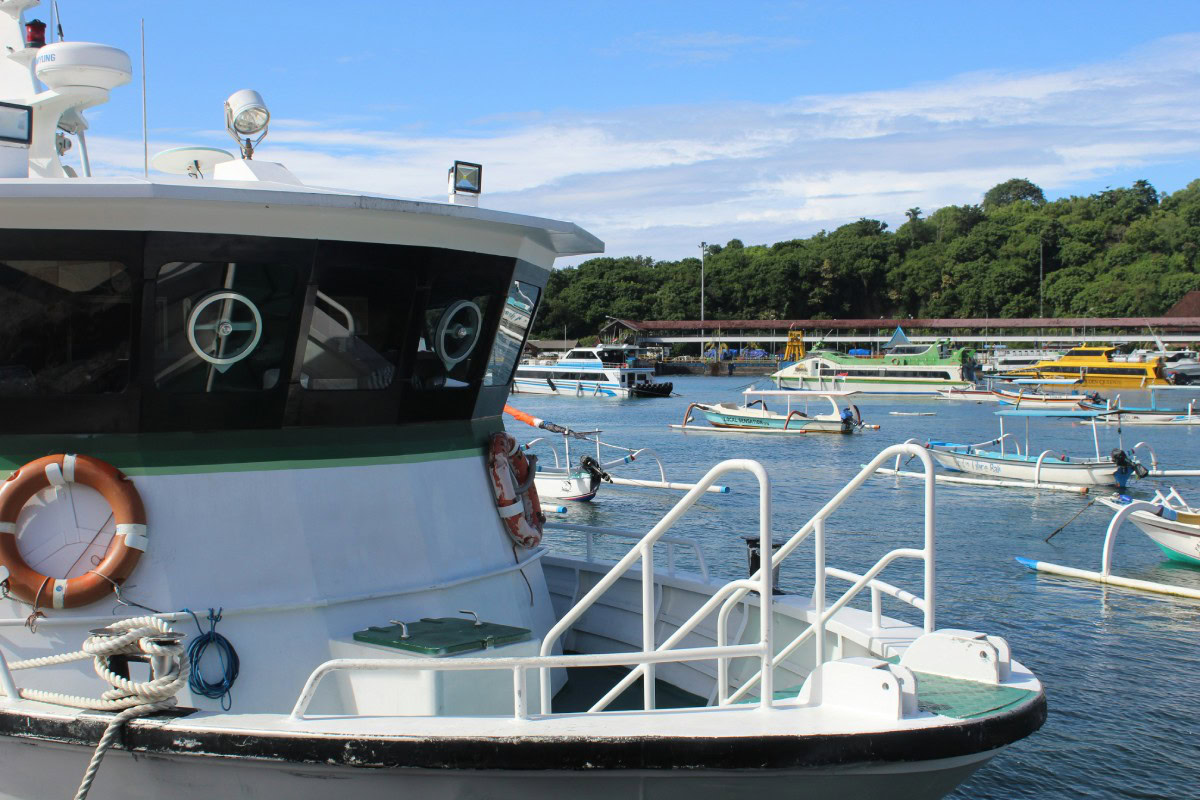
If you’re planning to explore the stunning islands off Bali’s coast, the most convenient and comfortable way to get there is by fast boat or private charter. Private charters offer a more elevated experience, allowing you to skip the crowds and travel on your own schedule while enjoying a scenic ride across the turquoise waters.
Private Charters to Lombok or the Gili Islands
- Departing from Padang Bai or Serangan, private charters offer a smooth, direct trip with personalized service and plenty of room for your gear.
Sanur to Nusa Lembongan
- A short ride across calm waters, with private boats offering a quick and easy transfer to this idyllic island.
Sanur to Gili Islands or Senggigi Lombok
- Private speed boat charters make longer island crossings more comfortable and enjoyable, with refreshments and spacious seating for the ride.
Many luxury resorts and villas can arrange private boat transfers that include door-to-dock service for a completely stress-free experience. Whether you’re headed to the serene beaches of Nusa Lembongan or the remote beauty of the Gili Islands, a private charter ensures your journey is as memorable as your destination.
Things To Do in Bali
(besides surfing)
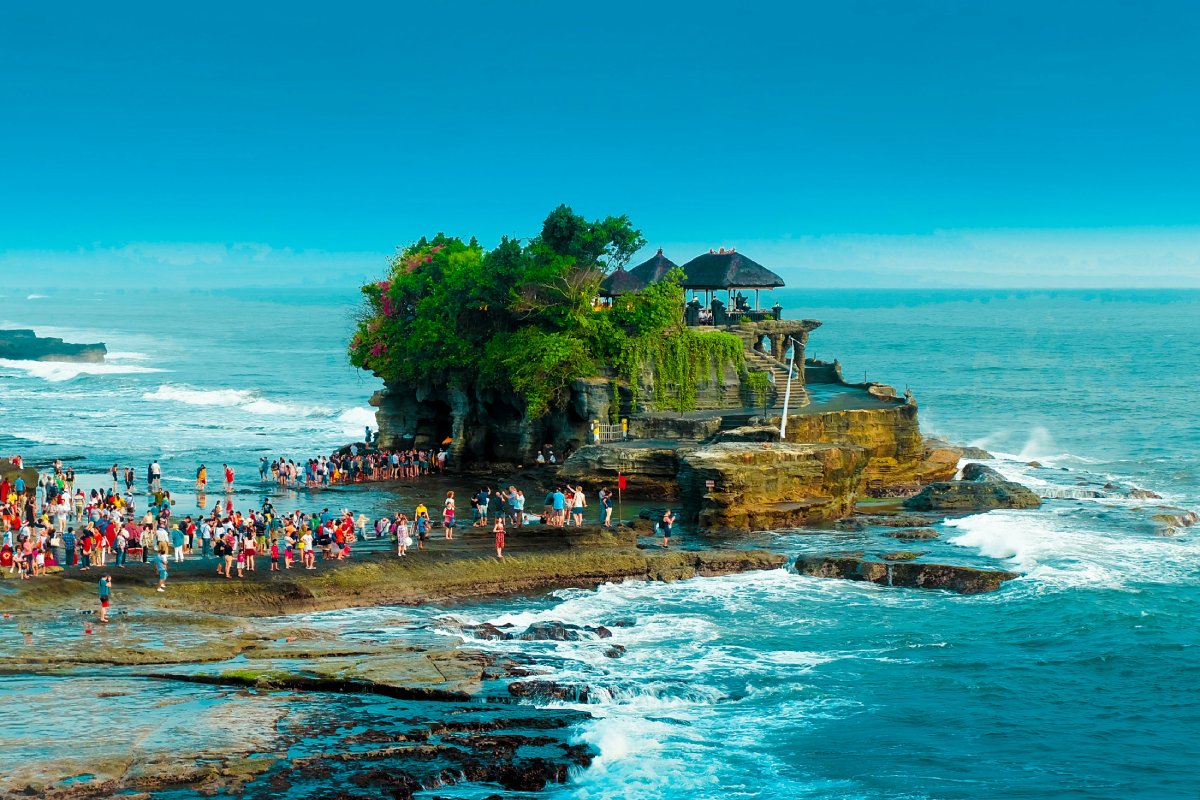
Visit Temples and Sacred Sites
Bali is home to thousands of temples, each with its own unique beauty and spiritual significance. Don’t miss Tanah Lot (perched on a rock in the sea), Uluwatu Temple (famous for its cliffside views and sunset Kecak dance), and Tirta Empul (known for its sacred water purification pools). Respectful dress (sarong and sash) is required at all temple sites.
Visit Waterfalls
Bali’s waterfalls are worth the trek. Head to Tegenungan, Tibumana, Sekumpul, or Leke Leke for a refreshing swim surrounded by tropical jungle. Most require short hikes, but the views and peaceful settings are always worth it.
Explore Rice Terraces
The island’s iconic rice terraces, especially those in Tegallalang and Jatiluwih, are postcard-perfect and a UNESCO-recognized part of Bali’s cultural heritage. Walk along the narrow paths or simply take in the views over a fresh coconut.
Go on a Volcano Trek
For adventure lovers, hiking Mount Batur at sunrise is a must. After an early morning climb, you’ll be rewarded with panoramic views of Lake Batur and Bali’s surrounding peaks. It’s a moderately challenging trek, typically done with a local guide.
Take a Yoga or Wellness Class
Bali is a global wellness destination, with classes, retreats, and healing sessions in abundance—especially in Ubud, Canggu, and Uluwatu. Try a yoga class overlooking the jungle, book a sound healing, or unwind with a Balinese massage at a local spa.
Snorkeling and Diving
The waters around Bali are home to vibrant coral reefs, manta rays, sea turtles, and even mola mola (sunfish) in season. Top spots include Nusa Lembongan, Nusa Penida, Amed, and Tulamben (the latter of which is famous for its WWII shipwreck dive).
Go on a Catamaran or Island-Hopping Trip
Take a day trip by catamaran or speedboat to Bali’s nearby islands—Nusa Lembongan, Nusa Ceningan, and Nusa Penida—for snorkeling, cliff jumping, or simply relaxing by turquoise water. Many tours include snorkeling stops, beach lunches, and incredible photo ops.
ATV and Jungle Tours
Explore Bali’s backroads on an ATV tour through rice paddies, muddy trails, and rivers, or hop in a jeep for a scenic off-road adventure into the volcanic landscapes near Mount Batur.
Cooking Classes
Learn the secrets of Balinese cuisine in a hands-on cooking class. Start by visiting a local market, then cook traditional dishes like nasi goreng, satay, or lawar with guidance from a local chef.
Traditional Balinese Dance and Culture
Catch a live performance of Balinese dance at the Ubud Palace or other cultural venues around the island. These intricate, expressive dances are deeply rooted in Bali’s Hindu traditions and often accompanied by live gamelan music.
Visit Local Markets and Boutiques
Bali has a thriving art and design scene, and its markets are full of locally made treasures. Shop for handwoven textiles, silver jewelry, wood carvings, ceramics, and natural skincare products at markets like Ubud Art Market or Samadi Sunday Market.
Sunset Spots and Beach Bars
Even if you’re not surfing, Bali’s beaches are perfect for winding down the day. Enjoy sunset views with a cocktail at a beachfront bar in Canggu, Seminyak, or Uluwatu. Enjoy beanbags in the sand, cold Bintang, and live DJs as the sky lights up.
Frequently Asked Questions
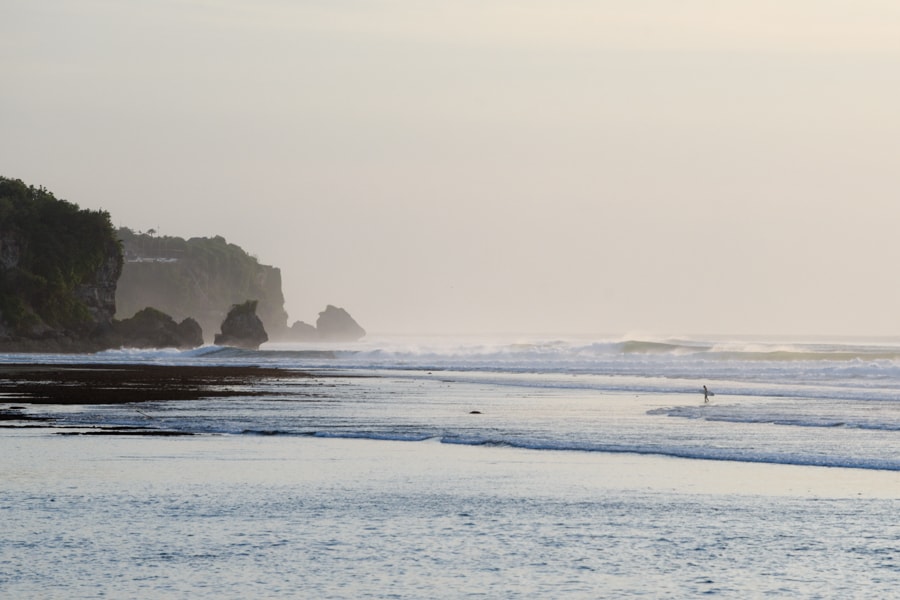
Surfing in Bali is just as safe as most other parts of the world. The same safety fundamentals apply to Bali as everywhere else: respect the ocean, know your limits, and be realistic about your surf abilities.
While Bali is known for powerful expert-level waves, there are plenty of intermediate and beginner surf spots as well. And at the end of the day it all comes down to the current ocean conditions and swell, as the ocean is continually changing. A good surf guide or surf instructor will know where to take you surfing depending on your experience level.
Bali is one of the best places in the world to take the family. The locals are friendly, the culture is vibrant, there are activities, adventures, and tasty treats everywhere, and there are waves for every level of surfer.
Bali has year-round surf, so the best time to surf in Bali depends on what waves you want to surf, as different breaks and parts of the island light up in different seasons. May to September is Bali’s cooler dry season, which is the best time for Bali’s west coast. The west coast has some of the island’s most notable breaks on the Bukit Peninsula (Uluwatu, Padang Padang, etc.) and in the Canggu area.
November through March is Bali’s wet season, which brings the best conditions to the east coast breaks, like Keramas and Sanur.
If you’re a beginner, any time of year is a good time to surf Bali, but we recommend the dry and shoulder seasons to avoid the rain.
While Bali is best known for its advanced waves, there are lots of options for beginners in Canggu and elsewhere on the west coast, including Old Man’s and Medewi.
While there are sharks in Bali, there’s no need to be worried about them, as the vast majority are small reef sharks, which are typically shy and harmless. Since 1990, there have only been five shark attacks in Bali, none of which have been fatal—and they all happened at a river mouth surf break located far away from the main surf hubs.
While there are a handful of different surf hubs in Bali, the two most popular places to stay are the Bukit Peninsula and Canggu. The Bukit Peninsula is home to some of the most famous breaks in Bali, like Uluwatu and Padang Padang, while Canggu is full of beach break peaks and a good option for beginner and intermediate surfers. Vibe-wise, the Bukit Peninsula offers a quieter country vibe, while Canggu is a much busier area with a lot more development, action, shops, and restaurants.
Travel Insurance
While we’d rather not think about getting injured while traveling, there are too many cases of people who didn’t think about insurance and get nailed with crazy medical bills after the matter.
You know the deal—better safe than sorry. Battleface or World Nomads Insurance offer very comprehensive travel insurance and cover lots of activities, including surfing and ocean sports. You can easily check them out and get a fast quote below.
Get a battleface Insurance Quote >>
Get a World Nomads Insurance Quote >>
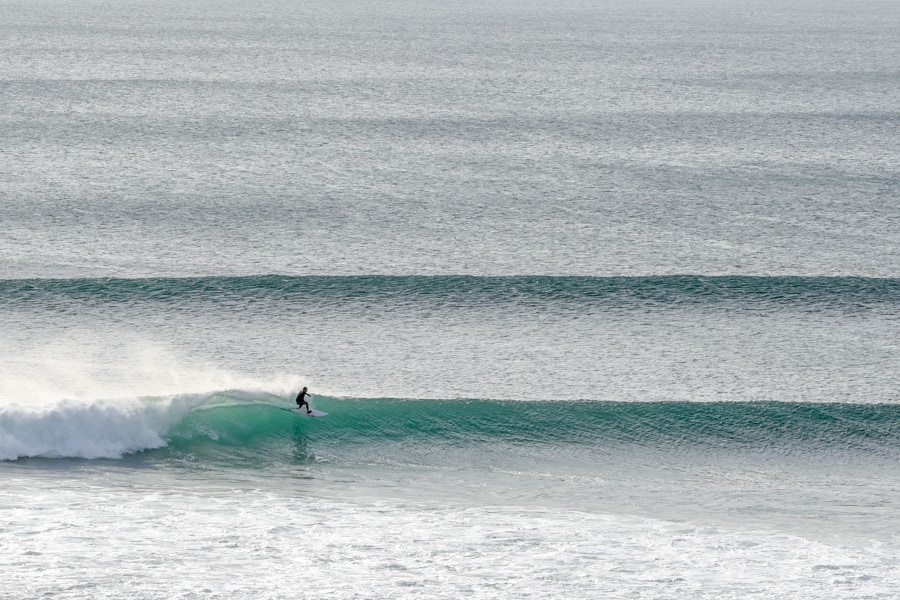
We hope this guide to Surfing Bali will help you plan an amazing trip. Be sure to check out our ultimate Surf Trip Packing List for a full breakdown of everything you might want to take with you.
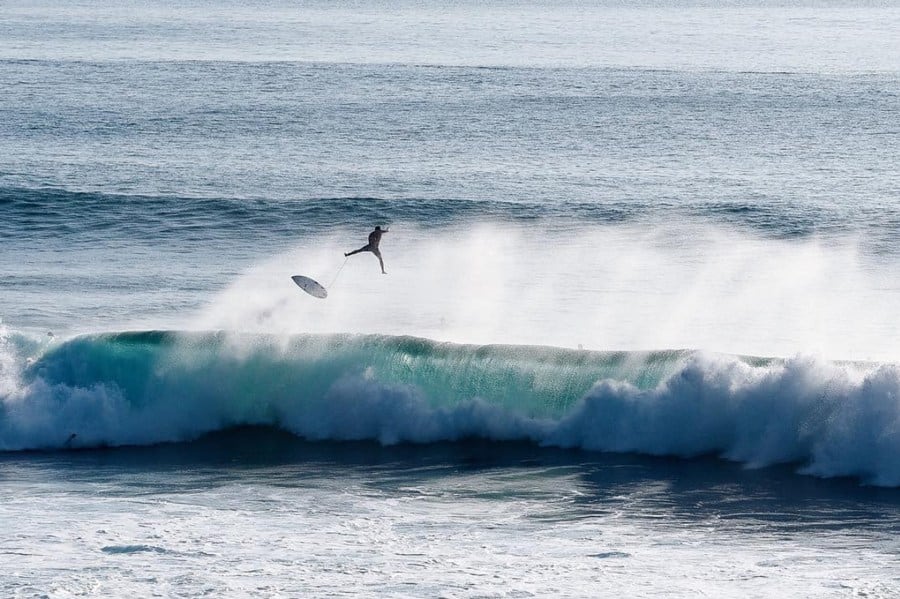




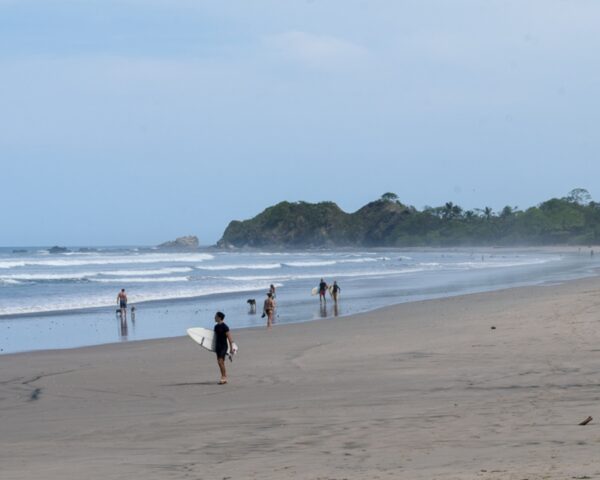


Brilliant summary – just what I was looking for. Thank you!
Wonderful! You’re very welcome 🙂
Thanks Guys
It took me a while to find you, but so glad I did, you have the best review/report on surfing Indonesia that I have found.
Regards Wayne
Thanks for stopping by, Wayne, and for the nice feedback. Glad you found Lush Palm to be a helpful resource! We’ll see ya around, cheers
Would you recommend this as a place for beginner surfing lessons? My pre-teen daughter and I would like to try but have no idea where to start, and I’m wondering if adding this onto an upcoming trip would be a good idea. Thanks!
Hey Jude, yeah, Bali is a great place for beginners to learn to surf. While Bali is known for having epic waves that cater to more advanced surfers, there are plenty of surf camps and surf breaks that are more mellow for beginners to learn to surf too. So no worries! You and your daughter would have an amazing time learning to surf in Bali! Enjoy!
Eric,
How crowded is Uluwatu during the shoulder season? I usually surf San Diego.
During high season how crowded is Uluwatu?
It can get pretty darn crowded depending on what you’re used to. Probably anywhere between 20-50+ surfers in the water trying to surf the same peak depending on the conditions, tides, etc.
Thank you for creating this guide! It was super helpful in planning our surf trip to Bali.
Our pleasure Warren! Stoked you found it helpful for your trip. Hope you have a great one and score!
Great guide, hope we can get included in the Surf resort for the 2020 version with our surf resort in Bingin.
Hi, could I also get your driver recommendation? Cheers!
Hey Alex – I just sent you an email with his info! Cheers
Hi Eric! Wonderful article and very informative. I’ll be in Sanur next week and was wondering if there are any beginner/intermediate surf spots and surf shops/rental nearby? Could you recommend the best way to get to these spots if travelling alone?
Hi Jimmy! Thanks. Hope I’m catching you in time. Some of the best beginner spots can be found at Canggu, Padang Padang Right (a soft inside right), Balangan and Dreamland which are all on the other side of the coast. As for intermediate spots, in my experience, places like Uluwatu, Impossibles, and many other breaks can be alright for an experienced intermediate surfer on the right day (smaller swells) and tides (usually a mid to higher tide). The east side of Bali is riddled with breaks that cater to upper-level intermediates to advanced/expert surfers. There are lots of strong currents to navigate and very shallow and dry reefs to watch out for. A scooter is a great way to get around, but I would strongly suggest you seek out an experienced local guide or surf camp so you could pick up valuable insights that could make all the difference before going it alone.
Hi. Can you recommend a driver for the whole day, I want hire hire one for full 5 days.
Hi Sean, yeah, we have a recommendation for you. I just sent you an email with more info.
Cheers!
Great post. It is very informative post for everyone I love reading this information. This is a perfect blog about bali camp. Keep posting and keep sharing like this.
Any suggestions for a surf guide to take us around.
Thank you
Hi Thomas, thanks for reaching out. We don’t have any personally vetted recommendations at the moment, however, we will be establishing a trusted network of surf guides to recommend in the future.
Hi guys,
Thanks for the wonderful guide! What would you recommend as a good beach/break for intermediate/beginner surfers that doesn’t get too crowded?
Hi Seth, our pleasure! Check out Balangan for sure. It can get busy but usually not too crowded. There are warungs/cafes right on the beach and the waves are typically pretty mellow there. Impossibles is a fun wave for intermediate level surfers on smaller days, but there is not much of a beach unless you go around the corner to Bingin which is only a few hundred yards south. Best to hit on a mid to lower tide. Hope you score some fun ones! Enjoy your trip!
Hello guys, love your page congrats, i was wondering if you know a cheap/good place to stay in lembongan near the waves, thank you and all the best!
Hi Carmelina, Thanks for your kind words! So happy you’re enjoying the site! In Nusa Lembongan, most of the surf breaks are pretty far offshore (like Lacerations and Shipwrecks), so many people take boats out, or from Jungutbatu Beach (the Main Beach) it’s about a 20-minute paddle. ‘Playgrounds’ is one of the easiest breaks to access because it’s closest to shore and it’s also one of the most user-friendly breaks. Not sure how cheap you’re looking for, but Song Lambung Beach Huts and Lembongan Cliff Villas are as close as you can get to Playgrounds, are nice hotels, and start at around $50 USD per night. If you’re looking for cheaper, Mojosurf Camp Nusa Lembongan has dorms for around $15 USD per night. Hope you have a great trip! Happy travels!
Great article. I definitely got a lot from reading this. Thanks for sharing! Heading to Bali for a week and looking to get barreled. Sounds a lot like Thailand and I love how you itemized the daily costs, but also provided insight on the reef. I’ll surely bring booties for the trip.
Awesome, our pleasure, thanks! Glad you found the article to be helpful. Have fun in Bali, it’s a magical place and there definitely plenty of barrels to seek out. Good luck and safe travels!
Great info on surfing in Bali! I’m headed there in June with my girlfriend who charges and we got some great advice from Eric.
Thanks Greg, glad we could help! How was Bali?!